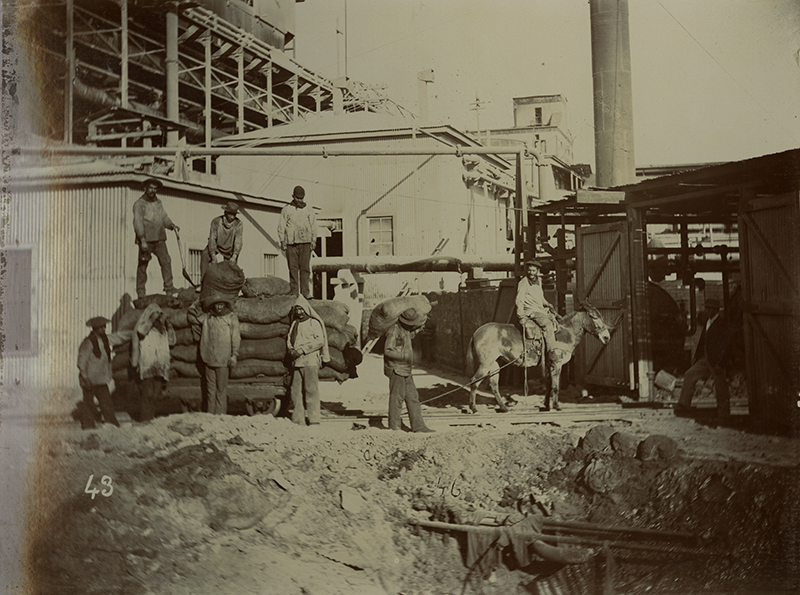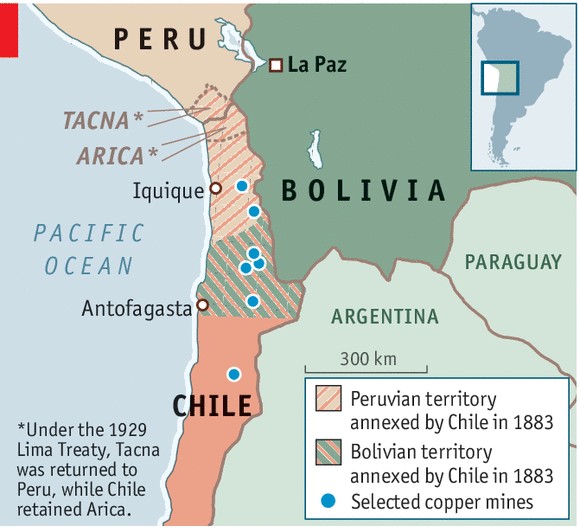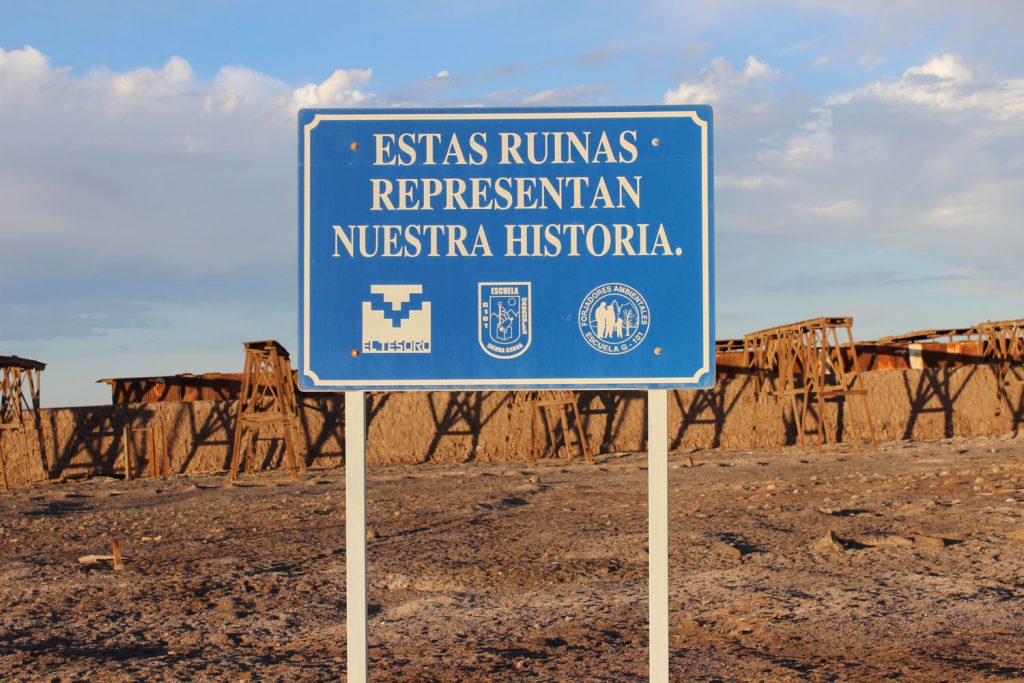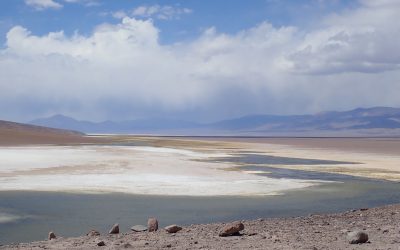It was the afternoon of December 21, 1907. Thousands of workers, worn out by the ruthless and unworthy conditions in the salitreras, gathered in the school of Santa María de Iquique, a place that will never be forgotten, destined to become a black spot in the history of Chile. A common struggle, a strike against the oppression of a colonialist entrepreneurship that, more than any other, marks the period known as “cuestión social” (social question). It is 3.30 pm, the troops of Roberto Silva Renard arrive, general at the service of President Pedro Montt and emblem of the repression against the demonstrations of the working class. A sad day for Chile, a day of massacre that inevitably marked the history of the mining conditions of the country: more than 2000 victims including men, women and children.
Hard work, poor health conditions, very low wages and food at the limit of subsistence. These were the conditions which all stable workers in the large saltpetre refineries, the so-called salitreras, had to deal with and which outline the causes at the basis of the so-called “social question in Chile”, the period between 1880 and 1920 during which more and more manifestations and strikes against the social problems of the working and non-working class were taking place. Theaters, schools, churches, grocery stores and public spaces made these “saltpetre offices” into real almost self-sufficient industrial centers, created with the intention of converting into the permanent home of hundreds of Chilean, Bolivian, Peruvian and Argentine families, thus becoming the only reality of life for these people. It was precisely in that period, in particular from 1890 to 1925, that the country experienced the peak of the nitrate mining era. Overall, however, we are talking about a historical context of social poverty and exploitation that characterized Chile, Peru and Bolivia for more than a century, from the construction of the first offices in 1810/12 to the invention of synthetic nitrate in the ’30s of the 20th century through the Haber process.
Over the span of 120 years, the regions of Antofagasta and Tarapacá, in the heart of the Atacama Desert, were the undisputed locations for more than 200 salitreras, occupying the less Andean areas of these large desert territories.
Nowadays it is still possible to get a vague idea of this reality by visiting the few salitreras still standing, which appear to any tourist as real ghost towns. In addition to those of Chacabuco, which was used as a concentration camp during the Pinochet regime, Pedro de Valdivia and María Elena, two are the most emblematic and the most visited by tourists from all over the planet. I’m referring to the saltpetre offices of Humberstone (former refinery of La Palma) and of Santa Laura, which are both located about 50 kilometers east from the coastal city of Iquique, in what is known as one of the flattest areas of the Atacama desert, and both declared national monuments and UNESCO World Heritage Site.
María Elena, which is originally known as salitrera “Coya Norte”, is the only saltpetre office still in operation and used for the production of saltpetre through the Guggenheim system.

But what exactly is saltpetre?
«As he that taketh away a garment in cold weather, and as vinegar upon nitre, so is he that singeth songs to an heavy heart.»
Saltpetre, also known as sodium nitrate, nitro or soda nitrate, is a mineral known since ancient times, as this famous passage from the Book of Proverbs has clearly demonstrated. Nitrum, as it was called by the Romans, who used it as a natural detergent in their inevitable thermal baths. The true origin of saltpetre and therefore the discovery of its true nature and potential, is a circumstance that has been lost over the centuries, certainly dating back to several centuries before Christ, probably in some area of ancient China or ancient Greece. The aspect that distinguishes this substance, which is a mix of sodium nitrate with potassium nitrate and which undoubtedly has attracted and involved the imagination of man since the ancient world, is its highly explosive power in contact with coal. These, not surprisingly, are two of the three ingredients necessary for the production of the oldest explosive mixture used by man. I am obviously talking about black powder, gunpowder, in which saltpetre is the most abundant ingredient (about 75%) and the element that acts as an oxidant, thus revealing itself to be the oxidizing ingredient of the mixture, leaving the nature of fuel to sulfur and coal. Therefore, apart from its use as a propellant and fertilizer, it is easy to understand how throughout history saltpetre has been constantly used for one of the contexts that most reflects the nature of man: war.
It was in the first decade of the 19th century when the fortunes of the nitrate market and, therefore, of the entire context linked to the production of saltpetre, changed radically. I refer to the advent of caliche extraction and refining industry. For more than 100 years, the pivot of the nitrate industry revolved around the sequence of three techniques: the “de paradas” system, the Shanks system and the Guggenheim system. All these techniques were united by the extraction and refining process of nitrate salt deposits, the so-called caliche, from the Quechua word “cachi”, salt, which is widespread in arid or semi-arid areas of the Earth. In Chile, caliche is known as nitratine or “Chile saltpetre”, which presents itself mixed with sand and other salts present on the surface.
But what was the real economic context of saltpetre?
As it is widely known, Chile is a country that for centuries has attracted the curiosity of investors from all over the world intent on giving value and exploiting the country’s enormous mineral potential. In recent decades, due to the growing demand and use of electrical conductors and batteries for the most varied industrial contexts, the exploitation of the great northern territory has revolved around two products of the precious Atacama Desert: copper and lithium (I recommend reading the article “Copper and lithium rush – The environmental threat”). At the end of the 19th century, however, things were very different and much of the economic market revolved around ideals of European minds. At that time, Chile was a completely different country than it is today, a scarsely populated and very poor country which, let us remember, only gained independence from Spain in 1818. The news of the discovery of large saltpetre deposits in the Atacama Desert took a short time to cross the great Pacific Ocean. That of saltpetre was considered as the long-awaited opportunity for many European investors of that time, the ideal time to give free rein to investments in foreign mines. The salitreras are in fact the result of a radical change in the country’s economic system, which until the last decades of the 19th century had been governed by a predominantly agrarian context and which, starting from 1884, saw enormous migratory flows from the countryside to the new mining centers, ending up almost completely immersed in the incessant investment plans of European minds who, during a good part of the 19th century until the first decades of the following one, recognized saltpetre as a real fortune.
What was the real intention of these entrepreneurs?
Making money through territorial and human exploitation, in a powerless country which was at the total mercy of their intentions, offering the possibility of enriching the war potential of theirs. These “owners of saltpetre” came from different countries: Chile, Peru, Bolivia, England, Germany, United States, Italy, France and even Croatia. But, as I will explain shortly, it was around British economic ideals that the whole nitrate industry revolved the most.
Saltpetre thus provided the perfect excuse for these entrepreneurs to proceed with huge investments in the market, giving them the opportunity to take control of a good slice of the Chilean economy and even managing to control the world monopoly of nitrates in three locations: Bolivia and Peru, from 1830 to 1884, and then in Chile, in the period between 1884 and the 1930s, during which the nitrate market became the main economic activity of the country.

At this point a few questions may arise spontaneously. Why did Chile experience its nitrate economic peak right from 1884 and not before? What does this famous historical date hide?
To be able to answer these questions it is necessary to take a step back, to the period in which the nitrate market in Chile was slowly arising. As already mentioned earlier, at that time the country was very different from how it seems to us nowadays, also from a territorial point of view. In the period between 1830 and 1879 the northern regions of Antofagasta and Tarapacá, in whose territories the vast majority of the nitrate offices were concentrated, were in fact shared among Chile, Peru and Bolivia on the basis of two international treaties stipulated in 1866 and in 1874 by Chile and Bolivia, in which the only issues under debate were the establishment of the respective territorial borders on the Atacama desert, the exploitation of the deposits of guano existing along the coast and, finally, the export rights that weighed on the exported minerals and, therefore, almost exclusively on saltpetre.
Without going into details, the issue around which the dispute between these countries revolves was the increase of the tax set by the government of La Paz on the resources extracted by Chile in the Bolivian territory, to which Chile obviously decided not to submit. The cancellation of the increase of this tax and the claim of the salitreras belonging to the Chilean company CSFA (Compañía Anónima de Salitres y Ferrocarril de Antofagasta) by the Bolivian government is recognized as the real cause of the hostilities.
In the morning of February 14, 1879, the occupation of the city of Antofagasta by the Chilean forces will give definitive green light to the bloodiest and most suffered conflict in the history of that part of the world, second only to the brutal and terrifying episode of the conquistadores. I refer to the Pacific War of Chile or, more commonly and, in my opinion, more correctly named “war of saltpetre”, a conflict that lasted 4 and a half years fought between Chile, Bolivia and its ally Peru, in the name of the commercial hegemony on the richest territories of the Atacama Desert. The hostilities definitively ended on October 20, 1883 and saw Chile as the winner of the conflict, with the consequent conquest of the disputed regions and which, in numerical terms, correspond to 400 kilometers of coastline, from Antofagasta to Arica, and 120,000 square kilometers of desertic territory. Bolivia, by giving up the rich region of Antofagasta, lost its direct access to the Pacific Ocean forever, while Peru found itself giving up the regions of Tarapacá and Arica and Parinacota.
It was 1884, the year in which the definitive commercial hegemony over saltpetre, as well as over any other mineral resource hidden by the colored sands of the great desert, began in Chile. The acquisition of the undisputed control of the whole west coast of the so-called “Cono Sur” (Southern Cone) allowed Chile to also take possession of one of the best natural fertilizers then known, guano, whose properties as an excellent fertilizer gave hope of a recovery of the fertility of the exhausted lands of old Europe. The long-awaited time by many Europeans and South Americans investors had finally come.

Let’s therefore try to outline the characteristics of the nitrate market in Chile.
What were its characteristics and what role did England play in all this?
Between 1895 and 1899 the existence of 48 nitrate offices was recorded; between 1910 and 1914 this number had almost tripled to 118 offices. These simple data clearly make us understand that most of the salitreras were built within 30 years, considering the end of the conflicts as a decisive turning point for major European investments. The saltpetre market is considered one of the most impure commercial realities in South American history. This consideration originates from the modalities on which the mining market itself was based which, without any doubt, allowed many entrepreneurs to enrich themselves beyond all limits, through the sale related to overseas exports of the precious mineral, so much so that it was considered and called “white gold”. The huge European and South American investments together with the state taxes for the numerous mining activities in Chilean territory, represented the real sources of income for the country, which in a short time recognized saltpetre as an extraordinary opportunity. But this whole economic circle hides another truth. It is true that Chile used this thriving market to enrich its pockets, using its revenues to stimulate the country’s economic development by focusing on industry, education and construction. And so it was. But the reality is that the whole market revolved entirely around European interests, especially those of England which, in addition to being the largest and most active center in the known world, more than any other country dictated the rules of trade, from the system to be adopted to the rules to be observed. In fact, most of the goods, traders, ships and freights themselves were English, who were among the first to arrive in that remote overseas world. Taking advantage of the important sums of money that ended up in the coffers of the Chilean state, the European investors ended up taking part in the system imposed by the English Crown which had the power to establish capitals, profits and prices in pounds sterling and not in the currency of Chile, Chilean peso, a currency which, for not being based on gold, found consistency only in the sale of exchange letters and trade operations in pounds sterling. Not only did investments by British entrepreneurs have a strong impact during the last two decades of the 19th century but, as often happened, many mining companies of other nationalities based their business on British capital. This undisputed control of the market, considering the remarkable amount of goods on sale, had the advantage of even causing an increase in the exchange rate between the pound sterling and the Chilean peso, a rate that, of course, was favorable to the pound. Therefore, as sales increased, the exchange rate fluctuated at much higher quotations, which resulted in purchases getting far less pesos per pound than they corresponded to an average exchange rate. For the European countries providing capital this meant making a big profit in a foreign currency, but at the same time this reality turned into a “silent” damage for the country coffers which, despite being well aware of the phenomenon, did nothing to regulate the market, finding itself powerless and at the mercy of the system in place. This was the pivot around which the “free” nature of the nitrate market revolved.
Things continued this way until the 1920s, when the slow methods of the saltpetre offices were in competition with the German laboratories, the first to discover and dedicate themselves to the production of synthetic saltpetre, the future of this “white gold”. Slowly, the South American nitrate market was coming to an end, with decreasing sales and the gradual closure of the nitrate offices, leaving tens of thousands of workers on the street, in a country whose currency further lost its value due to the lack of pounds in circulation.
The Great War, the conflict par excellence, was the last real war context behind which the nitrate market reigned, in which thousands of poor families saw in the saltpetre their hope of work, of life, and which are now only an indissoluble memory.






0 Comments